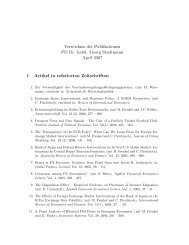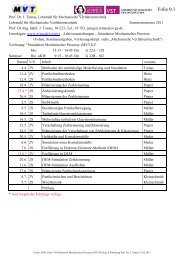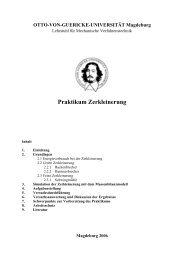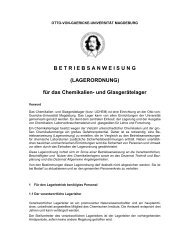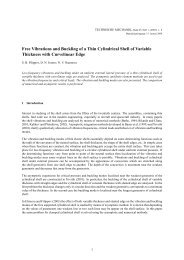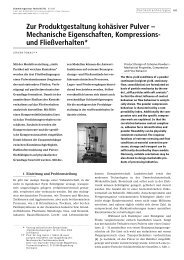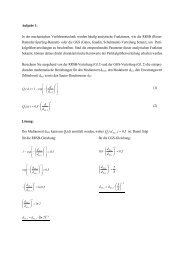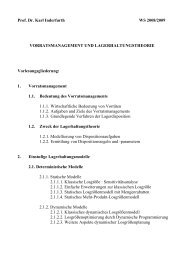Mechanics of nanoparticle adhesion â A continuum approach
Mechanics of nanoparticle adhesion â A continuum approach
Mechanics of nanoparticle adhesion â A continuum approach
You also want an ePaper? Increase the reach of your titles
YUMPU automatically turns print PDFs into web optimized ePapers that Google loves.
<strong>Mechanics</strong> <strong>of</strong> <strong>nanoparticle</strong> <strong>adhesion</strong> — A <strong>continuum</strong> <strong>approach</strong> 153 ⋅r3 12 ,⋅FHJKR,K0 , *r = (24)Eis reduced to the pull-<strong>of</strong>f contact radius, i.e.,3K, pull <strong>of</strong>f=K,04r-r / . (25)Additionally, with applying an increasing tangential force F T , the contact radiusr K is reduced by the last term within the square root:r F F F F F2⋅E4⋅G2 *33⋅r12 ,2 FT⋅ EK= ⋅ N+ HJKR ,+ 2⋅ * HJKR ,⋅N+ HJKR ,−*, (26)When the square root in Eq. (26) disappears to zero, a critical value F T,crit is obtained,the so-called “peeling” <strong>of</strong> contact surfaces [64, 88]:F2( 2HJKR , N HJKR , )⋅F ⋅ F + F ⋅G= 2⋅ (27)ETcrit , *An effective or net normal force (F N + F H,JKR ) remains additionally in the contact[54]. Considering F T > F T,crit , i.e., contact failure by sliding (see Mindlin[63]), the tangential force limit is expressed as FT = tanϕi⋅ ( FN + FH0). The <strong>adhesion</strong>force F H0 (index H0) is constant during contact failure and the coefficient(or angle) <strong>of</strong> internal friction µ i= tanϕiis also assumed to be constant for amulti-asperity contact [50, 81, 82]. This constant friction was <strong>of</strong>ten confirmed forrough surfaces in both elastic and plastic regimes [50, 81, 84], but not for a single-asperitycontact with nonlinear dependence <strong>of</strong> friction force on normal load[82, 84].Rearranging Eq. (26), the extended contact force–displacement relation showsa reduction <strong>of</strong> the Hertz (first square-root) and JKR contributions to normal loadF N which is needed to obtain a given displacement h K :**2 *E34⋅E ⋅FHJKR,3 FT⋅ EN= ⋅ ⋅12 ,⋅K− ⋅12 ,⋅K−*F 2 r h r h3 3 4⋅G*(28)However in terms <strong>of</strong> small particles (d < 10 µm), the increase <strong>of</strong> contact areawith elastic deformation does not lead to a significant increase <strong>of</strong> attractive <strong>adhesion</strong>forces because <strong>of</strong> a practically too small magnitude <strong>of</strong> van der Waals energy<strong>of</strong> <strong>adhesion</strong> (Eq. (18)). The reversible elastic repulsion restitutes always the initialcontact configuration during unloading.Consequently, the increase <strong>of</strong> <strong>adhesion</strong> by compression, e.g., forming a snowball, the well-known cohesive consolidation <strong>of</strong> a powder or the particle interac-



